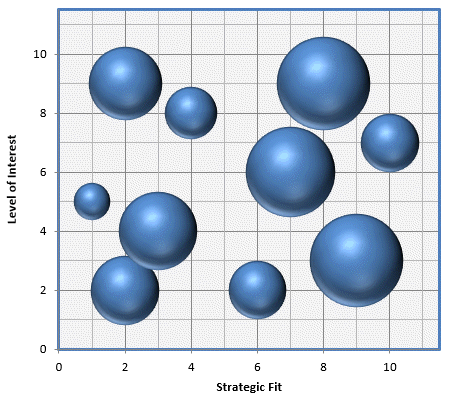What do you do when you have too many leads? While this is a nice problem to have, it is still a problem. You may have limited resources for follow up and you wish to deploy them effectively.
In my last post, I discussed the importance of “keeping score”, measuring the effectiveness of your lead-generation activities. In this post, I’d like to expand my thoughts about the administration of your sales efforts.
Not all leads are equal.
Some may come from customers who are too small, others who are too distant. And some which are obviously not a fit for what you do. When you created your social media campaigns, you may have targeted some customers on the fringe of your desired profile.
There may also be differences in the need or enthusiasm a customer shows for what you do. If your product or service is relieving a pain point for a customer, the emotional aspect can sometimes become the most important determinant in the buying decision.
What is needed is a preliminary way to sort and filter your leads so you focus on the important ones.
In the table below, I illustrate 10 leads for a sample business. I presume some industry knowledge for myself and feel comfortable about assessing leads.
For each lead, I’ve made an assessment of the “Buying Power”, which is my way of estimating the long-term value of the potential customer. I also added a 1-10 rating on my instincts about the “Strategic Fit” for the lead. In the last column, I added a 1-10 rating for “Level of Interest” shown by the potential customer. Unless you are specially skilled and patient about reading rows and columns of numbers, this tabulation doesn’t tell you much.
Unless you are specially skilled and patient about reading rows and columns of numbers, this tabulation doesn’t tell you much.
However, in the next step, I put the same information into a bubble chart which is shown below.
The upper right-hand quadrant contains the leads where both strategic fit and level of interest are above average.
The size of the bubble represents the buying power of the potential customer. In my example case, there are two leads which appear to be sizable and one which is relatively small.
Note in the lower right-hand quadrant there is a sizable lead where strategic fit is high but interest low.
If I was managing the leads for this company, my first efforts would be with the two sizable leads in the upper right-hand quadrant. I would also see what I could do to increase the interest level of the sizable lead in the lower right-hand quadrant.
The cost to acquire a customer might be a consideration with the others. If the cost is high, I probably would look for more leads as my next step. If the cost to acquire a customer is low relative to their value, I might consider pursuing the small opportunity in the upper right-hand quadrant.
Obviously, the leads in the lower left-hand quadrant are ones to be ignored or archived if there are limited resources.
The leads in the upper left-hand quadrant have a risk. These are interested customers where the strategic fit is poor. While you might be able to make the sale to these, they could turn out to be unhappy customers in the future. If you don’t think your product or service is a fit now, it is unlikely to be a fit later.
For the record, I did not use a special application to create these tables and bubble charts. What I show in this post was generated using Microsoft Excel.
Enjoying this content? Click here to read the previous article in this series.
 About the Author: Bob Kroon is a coach for high-performing Founders, CEO’s, and Owners. He founded Expeerious, LLC (expeerious.com) in 2015 to exclusively focus on coaching the success of Top Executives. For over 25 years, Bob served variously as CEO, COO, Division President, and Group Vice President.
About the Author: Bob Kroon is a coach for high-performing Founders, CEO’s, and Owners. He founded Expeerious, LLC (expeerious.com) in 2015 to exclusively focus on coaching the success of Top Executives. For over 25 years, Bob served variously as CEO, COO, Division President, and Group Vice President.
The majority of his career was in manufacturing durable goods. Bob is an enthusiast and practitioner of Lean Thinking since 1986. He also has broad skills in M&A including financial modeling, deal structure, diligence, and post-close integration.
Bob’s current clients are diverse and include businesses in healthcare, agricultural products, robotics, luxury goods, and education.
To learn more about how Bob coaches and thinks, you can find over 200 questions he’s answered on Quora. Visit his website at: www.expeerious.com for additional blog posts.


